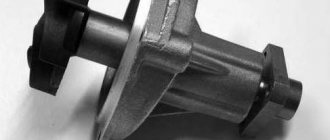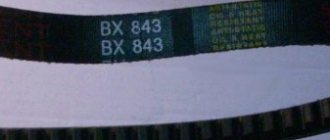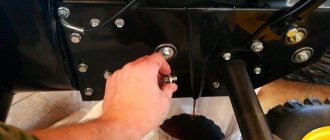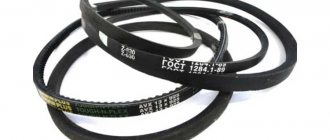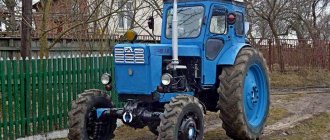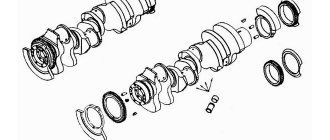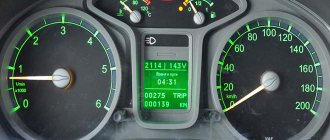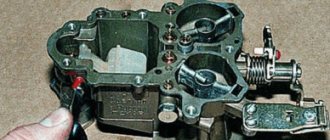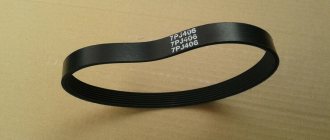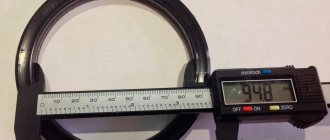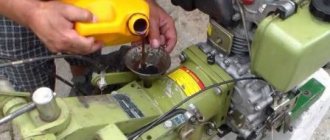The design of a snow blower includes several important and key elements. One of them is drive belts. Here they are needed in order to transmit torque from the drive shaft to the driven shaft. In fact, the ability of a snow blower to move on the ground and remove snow depends on the integrity and proper operation of the belt.
During operation, belts constantly come into contact with other elements, which leads to fairly rapid wear. That is, replacing belts on snow blowers is a standard procedure that all owners of snow blowers face.
The working principle of snow blower belts and their application
It is worth objectively recognizing that drive belts are one of the most frequently replaced parts in the design of snow blowers.
Every modern snow removal unit is equipped with 2 belts from the factory. The tasks they face are different, although the operating principle is identical.
The first type of belt is necessary in order to distribute the torque from the engine to the auger. The task of the second type of drive belt is to transmit torque to the wheels. It turns out that without one belt the auger will not work and snow will be thrown out, and without the second, the snow blower simply will not be able to move around the territory, since the wheels will not rotate.
It is quite simple to check whether any of the belts, or maybe both at once, have worn out and failed. Press the lever or button that moves the wheels and controls the auger. If the auger does not work, or the snow blower does not move, then there may be a problem with the belts. You can verify this by visually checking the parts.
What role do snowblower belts play?
Belts are one of those elements of snow blowers whose work is constantly associated with intense loads and high temperatures. Because of this, they need to be replaced regularly. If you ignore this need and continue to operate a snow blower with a faulty drive part, the operator risks further exacerbating the already faulty condition of his equipment.
Any self-propelled snow blower has 2 belts. Both of them work on a similar principle, but perform slightly different tasks in their essence. Elements of the first type are needed by the snow blower directly to obtain and distribute optimal torque parameters to the driven auger shaft. Parts of the second type do the same thing, but they distribute the resulting force to the wheels of the snowplow. In fact, the optimal combination of all operating mechanisms of a snow blower largely depends on the belts.
A malfunction of one of the snow blower belts is usually indicated by the lack of response of the machine’s working parts to pressing the corresponding buttons and levers.
What belts are used in snow blowers?
Before you start replacing, you need to find out what kind of belts are used on snow blowers. This is necessary in order to be able to purchase new consumables. Without knowing what is on the equipment, it is impossible to choose the right belt.
Toothed belts are used on modern snow removal equipment. Objectively, their strength indicators are quite high, and in this aspect they are practically not inferior to drive chains.
At the same time, timing belts are superior to chains due to more convenient operation, as well as low weight. The toothed belt is also capable of efficiently and efficiently transmitting torque to the operating shafts. Also a pleasant bonus for those who prefer to service the snow blower with their own hands will be the fact that it is easier to fix and install, even in conditions of limited work space.
The fact that a toothed belt is used on a snow blower does not yet fully make it clear which consumables you need to buy. There are 2 types of timing belts for snowblowers.
- Flat toothed. A distinctive feature of the part is its high strength. Therefore, such elements are usually installed specifically for the operation of the auger. Flat toothed belts are characterized by high strength and resistance to deformation. Therefore, the service life of the consumable is impressive. The design ensures synchronous operation of two augers at the same time, which adds stability to the operation of the snow blower.
- Double sided. This is a separate group of timing belts. Such parts are more suitable for transmitting torque simultaneously in several required directions. Therefore, double-sided timing belts are installed on the wheels of snow removal equipment. This option is considered optimal if the equipment is equipped with a gearbox with reverse gear. Additionally, it is worth noting good resistance to wear and mechanical damage.
But even such characteristics cannot make a part eternal. Wear and tear still occurs over time. And the task of the snow blower owner is to detect wear and tear in time, notice damage, and replace the part.
The option of installing a V-belt on the snow blower cannot be ruled out. It is distinguished by its trapezoidal profile and cross-section. The only problem is that this type of belt has a significant drawback. This is a looser fit than the other components of the snow blower. Although the belt is still capable of performing a number of functions. So many manufacturers decide to use a wedge-shaped consumable for installation on equipment.
Having familiarized yourself with the classification of belts for snow blowers, you can take a look at the possible and most common faults.
What types of snow blower belts are there?
To create snowblowers, gear parts are used. In terms of reliability, they are in no way inferior to chains, at the same time they are much more convenient to use and have less weight. Spare parts of this type perfectly transmit the rotational element to the shafts and are easy to fix in a small space.
Quite often, a gasoline snow blower and snow blowers of other types differ in that wedge strands with a cross section and a trapezoidal profile are placed there. They perform many functions, so it is impossible to do without its use when creating equipment.
Causes of belt wear and malfunctions
Since it is a consumable item, each part has a limited service life. Moreover, this period during which the part retains its functionality depends on several factors. Namely:
- workmanship;
- materials used for the drive belt;
- correct installation;
- manufacturing defects;
- technical characteristics of the snow blower;
- terms of Use;
- activity of equipment, etc.
The combination of these factors leads to the fact that the service life of the belt ultimately differs on different snow blowers. For some it may work for several seasons. For others, after just a few hours of total operation of the snow blower, the need to replace the part occurs.
There are several main reasons for wear and defects on drive belts, which become the reason for replacement.
- Long-term operation without stopping . Once you start the snow blower and start removing snow, it may take varying amounts of time. For some, 5-10 minutes are enough to clear the paths. Others load the equipment without stopping it for several hours. The longer the snow blower operates, the more actively all elements of the equipment heat up. High temperatures also have a negative effect on belts. Therefore, long-term use will cause the part to fail faster. This means that during operation you need to let the unit rest and cool down, and then continue clearing the snow.
- Frequent starts and stops . The opposite situation. The operator operates the snow blower in short sessions. I started the engine, ran it for a few minutes, then stopped the engine. And this is repeated many times. It is clear that situations are different. But it is better not to work on a snow blower in this mode. This greatly affects the wear of the starter, engine and belts themselves, and can also contribute to the formation of icing of parts. Stick to average work hours. Then nothing will overheat excessively, but also will not begin to wear out from frequent restarts.
- Downtime in the operation of the snow blower . It happens that one winter it snows actively, and a snow blower is needed literally every week. And sometimes there is a completely snowless winter. And there is no need for snow removal equipment. As a result, the car sits somewhere in the garage, idle. During this time, the belts may dry out and become cracked. Natural wear and tear from equipment simply not working. Like a car, a snow blower must operate for better safety, but at optimal loads. Therefore, it is a mistake to think that equipment is better preserved when stored in a garage. No, this can cause a whole range of problems and malfunctions. For the purpose of prevention, you need to let the snow blower work a little, even if you don’t need to remove snow. This is also good for the engine.
- Lack of lubrication. If equipment lacks lubrication, then wear becomes much more active. This leads to more frequent replacements.
Although belts cannot be called very expensive consumables, it is unlikely that the owner will want to turn the process of replacing them into a frequent routine.
To increase the service life of the belts, as well as extend the life of the snow blower without the need for maintenance, try to avoid the listed mistakes. Prevention is much better than repair and it is much cheaper.
Causes of malfunctions
But in order for the belts to last longer, it is worth understanding what could cause them to fail. This will help you replace this part of the snow blower less often, and also better understand the principle of operation of the device as a whole.
Belt wear
In general, any belt wears out, so replacing it is inevitable, but the fatal moment can be delayed. The following nuances of operation and omissions on the part of the owner can be called destructive for belts:
- Long-term operation of the snow blower without stopping. This method of operation leads to overheating of absolutely all parts of the equipment, and high temperatures are detrimental to the belt.
- Too frequent breaks during work. If you constantly press and release the starter, this can lead to faster failure of parts.
- Lack of necessary lubricant , that is, insufficient attention of the owner to his equipment.
If you avoid such operating methods that are negative for snow blower parts, the belt will “live” longer, and you will not have to change it often.
More complete information can be seen below:
Types of faults
Depending on the situation, a snow blower owner may experience a variety of belt problems.
Basically we are talking about the following problems:
- Overheating followed by deformation . Occurs if you work on a snow blower for too long, without breaks, and do not allow the equipment to cool down. Since the spare part is made of soft and elastic material, strong heating occurs under such a load. And then there is a natural deformation. The optimal operating mode is 10 minutes of rest after every hour of operation.
- Stretching . This happens to the belt if the operator abuses the pressure on the gas levers and the auger drive. Each press of the lever leads to tension on the part. This ultimately leads to the fact that the factory geometric parameters change. So try to press the levers only when necessary.
- Drying out . The belt may dry out if left idle for a long time. Also, when heated, the element loses its elasticity, gradually cracks and crumbles.
- Cliffs . This is usually a consequence of normal wear and tear, or the result of previous problems. A break will also occur if the belt is constantly in contact with heated mechanisms.
Snow blower owners are also faced with the fact that the belts simply get blocked during the next round of rotation on the shaft head. This situation occurs due to accumulated moisture, oil, and dust. They prevent the belt from moving normally. The problem is solved by periodic preventive cleaning of the compartment with belts from dirt that appears there and the snow itself.
V-belt and poly-V-belt: differences
Poly-V-ribbed parts, or ribbed parts, combine several types of snow blower belts, such as V-belts and flat types. Such parts have many wedges, which have a sawtooth shape in cross-section. The friction of the working surface of the drive component with the wedges causes the transfer of energy from the drive shaft to the driven shaft. The number of wedges depends on the design of the pulleys. Poly V-belts have the following advantages:
- work on small pulleys;
- high speed;
- little weight;
- low degree of sound vibration.
The wedges are made of polychloroplen. This material is non-flammable, can withstand sub-zero temperatures and has a high level of wear resistance.
What to choose for replacement
You can select spare parts based on the manufacturer's recommendations. Just look at the technical data sheet or instruction manual. They also often select analogues from trusted manufacturers.
Some of the brands under which good belts for driving wheels and augers on snow removal equipment are sold include:
- Patriot;
- Enifield;
- Al-Ko;
- ContiTech AG;
- Ariens;
- Rotary;
- Hyundai;
- MTD.
These are the main brands that are found on the Russian market and also deserve attention.
It’s not worth buying frankly cheap Chinese consumables. But at the same time, it is also impossible to put a taboo on belts from China, since the bulk of spare parts are produced there.
Belt for snow blower (aka snow blower drive belt, V-belt and toothed)
Belt for Ariens snow blower (13*925)
| Category | Ariens Snow Blower Parts |
Our guarantee - Special warranty and repair from 15-sotok.ru
Price: 750.00 rub.
Buy Remove from cart
Belt for snow blower Ariens 008-010
| Category | Ariens Snow Blower Parts |
| Catalog number | 008-010 |
| Compatibility | Snow blowers |
Our guarantee - Special warranty and repair from 15-sotok.ru
Price: 2,680.00 rub.
Buy Remove from cart
Belt for Husqvarna snow blower (wheel drive) 5324197-44
| Category | Husqvarna Snow Blower Parts |
| Catalog number | 5324197-44 |
| Applicability | Wheel drive |
| Compatibility | Snow blowers |
Our guarantee - Special warranty and repair from 15-sotok.ru
Price: 1,030.00 rub.
Buy Remove from cart
Belt for snow blower MasterYard MX8022/MX8522 (AOLIDA)
| Category | Spare parts for MasterYard snow blower |
| Catalog number | cco551Q |
| Applicability | Chassis |
| Compatibility | Snow blowers |
| Manufacturer | MTD |
Our guarantee - Special warranty and repair from 15-sotok.ru
Price: 1,980.00 rub.
Buy Remove from cart
Belt for snow blower MasterYard SB-051
| Category | Spare parts for MasterYard snow blower |
| Catalog number | MX8022/MX8522 |
| Applicability | Chassis |
| Manufacturer | MTD |
Our guarantee - Special warranty and repair from 15-sotok.ru
Price: 850.00 rub.
Buy Remove from cart
Belt for MasterYard snow blower (auger drive) V13*890 ST656 762E / LB4L-885 SB-050
| Category | Spare parts for MasterYard snow blower |
| Catalog number | SB-050 |
| Applicability | Auger drive |
| Compatibility | Snow blowers |
| Manufacturer | Gates true power |
Our guarantee - Special warranty and repair from 15-sotok.ru
Free pre-sale preparation
Price: 750.00 rub.
Buy Remove from cart
Belt for snow blower (auger drive) Patriot V10X720 PHG 55, 65, 551, 651
| Category | Patriot Snow Blower Parts |
| Catalog number | 003510340 |
| Applicability | Auger drive |
| Manufacturer | Patriot |
Our guarantee - Special warranty and repair from 15-sotok.ru
Free pre-sale preparation
Price: 1,850.00 rub.
Buy Remove from cart
Belt for snow blower (auger) MTD 754-04050 7801360
| Category | Spare parts for MTD snow blower |
| Catalog number | 7801356 |
| Applicability | Auger drive |
| Compatibility | Snow blowers |
Our guarantee - Special warranty and repair from 15-sotok.ru
Price: 3,100.00 rub.
Buy Remove from cart
Belt for snow blower MTD (auger drive) 754-0637 008-107
| Category | Spare parts for MTD snow blower |
| Catalog number | 008-107 |
| Applicability | screw drive |
| Compatibility | Snow blowers |
| Manufacturer | MTD |
Our guarantee - Special warranty and repair from 15-sotok.ru
Free pre-sale preparation
Price: 1,550.00 rub.
Buy Remove from cart
Belt for Murray/Candiana snow blower (self-propelled) 627856
| Category | Murray Snow Blower Parts |
| Catalog number | 579932MA |
| Applicability | Snow blower transmission |
| Manufacturer | MURRAY |
Our guarantee - Special warranty and repair from 15-sotok.ru
Price: 1,860.00 rub.
Buy Remove from cart
Belt for Murray/Candiana snow blower (auger drive) 624555
| Category | Murray Snow Blower Parts |
| Catalog number | 37X120MA |
| Applicability | Auger drive |
| Compatibility | Snow blowers |
| Manufacturer | MURRAY |
Our guarantee - Special warranty and repair from 15-sotok.ru
Price: 1,860.00 rub.
Buy Remove from cart
Belt for Murray/Candiana snow blower (auger drive) 627856
| Category | Murray Snow Blower Parts |
| Catalog number | 585416MA |
| Applicability | Auger drive |
| Compatibility | Snow blowers |
| Manufacturer | MURRAY |
Our guarantee - Special warranty and repair from 15-sotok.ru
Price: 2,650.00 rub.
Buy Remove from cart
Belt for Murray snow blower (auger drive) 1736421YP
| Category | Murray Snow Blower Parts |
| Catalog number | 1736421YP |
| Applicability | Auger drive |
Our guarantee - Special warranty and repair from 15-sotok.ru
Price: 1,950.00 rub.
Buy Remove from cart
Belt for snow blower (drive drive) Snapper 1733324SM
| Category | Snapper Snow Blower Parts |
| Catalog number | 1733324SM |
Our guarantee - Special warranty and repair from 15-sotok.ru
Price: 2,210.00 rub.
Buy Remove from cart
Belt for snow blower (drive) Murray 1733324SM
| Category | Murray Snow Blower Parts |
| Catalog number | 1733324SM |
Our guarantee - Special warranty and repair from 15-sotok.ru
Price: 1,850.00 rub.
Buy Remove from cart
Belt for snow blower MTD 3/8*26.680 754-04014
| Category | Spare parts for MTD snow blower |
| Catalog number | 754-04014 |
Our guarantee - Special warranty and repair from 15-sotok.ru
Free pre-sale preparation
Price: 1,450.00 rub.
Buy Remove from cart
Belt for snow blower (auger) MTD 008-969 (754-0430)
| Category | Spare parts for MTD snow blower |
| Catalog number | 008-969 |
| Applicability | Auger drive |
| Suitable for | Snow blowers MTD, etc. |
Our guarantee - Special warranty and repair from 15-sotok.ru
Free pre-sale preparation
Price: 3,200.00 rub.
Buy Remove from cart
The process of replacing a belt on a snow blower
If the check shows that the old belts have worn out and are no longer suitable for further use, then there is only one thing left to do - change them.
This kind of work can be easily done with your own hands. The design of snow blowers is such that there is nothing difficult to replace. The main thing is to follow the recommendations and follow the instructions.
- First, start the snow blower engine. You just need to let the equipment run for a couple of minutes in light mode at idle speed. This will allow the unit to warm up to the desired temperature.
- Next, unscrew the fixing screws, which will loosen the cables that connect the wheels or augers.
- Now carefully remove the cover of the protective housing. Most often it is plastic. Take the tool based on how the cover is secured.
- Under the cover you will see belts and nuts that secure the drive of the wheels and built-in augers of the snow blower.
- Unscrew the screws of the problematic belt. Just proceed with extreme caution. It is important here not to make any changes to the balancing of the snow blower elements.
- Tension the new belt, secure the fasteners and ensure the desired tension.
After assembling all components, be sure to check the result of the repair. Start the engine and let the equipment run for 10 minutes. Just at idle.
When the grinding is complete, press the drive lever 3-4 times and set the snow blower in motion. If everything works as normal, then the replacement was successful and you can continue to operate the equipment.
What belt problems do snow blower owners encounter?
Each new snowblower belt has its own individual working life, that is, the number of hours it can work in certain conditions. Often this resource is significantly reduced. The reason for this is the random malfunctions that owners of snow removal equipment encounter.
The most common problems with belts include:
- use the snow blower without pause. Absolutely every part of the machine needs rest, during which it can completely cool down. Since the part constantly operates at elevated temperatures, it is one of the first to require time to restore normal temperature. Working non-stop, the drive element of the snow blower begins to melt, which leads to deterioration of its original structure. To prevent this, you need to operate the snow blower intermittently - 10 minutes for every hour of operation;
- pressing controls too frequently. In order for the drive part to operate, the operator must press the appropriate lever or button. During this, the belt tenses and contracts. This has a bad effect on the integrity of the element and, over time, greatly stretches it;
- untimely servicing of the element. For normal operation of the rubbing part, it needs lubrication. If there is too little oil, the drive element will begin to heat up intensely, which can lead to cracks or rupture in it. To prevent this, the operator must constantly monitor the quantity and condition of the lubricant.
Another common cause of malfunction is snow and dust getting on the snow blower part. Often dirt and small stones seep into the compartment, which increase the load on the elastic drive element. To prevent this, the operator must ensure that a protective plastic shield is placed above the belt at all times.
The role of belts in the design of a snow blower
Drive parts are among the consumable parts of snow blowers that most often require timely replacement. Moreover, each snow blower is initially equipped with two belts, which guarantee proper operation of the machine in all weather conditions.
The function of the first type of drive elements is to transmit traction force from the motor to the factory auger of the snow blower. Parts of the second type play a similar role, but in their case, the traction force from the internal combustion engine is transferred to the wheel drive of the utility vehicle.
Spare parts of the first and second types are subject to constant intense wear, due to which they often fail. The standard controls of the snowplow will indicate their deformation or breakage. If the snow blower does not move when you press the gas lever, it means that the drive element connecting the engine and wheels has failed. Similarly, a snow blower owner can determine if the auger drive belt is faulty. If the snow blower mechanism does not rotate when you press the appropriate lever, then the drive part will need to be replaced.
